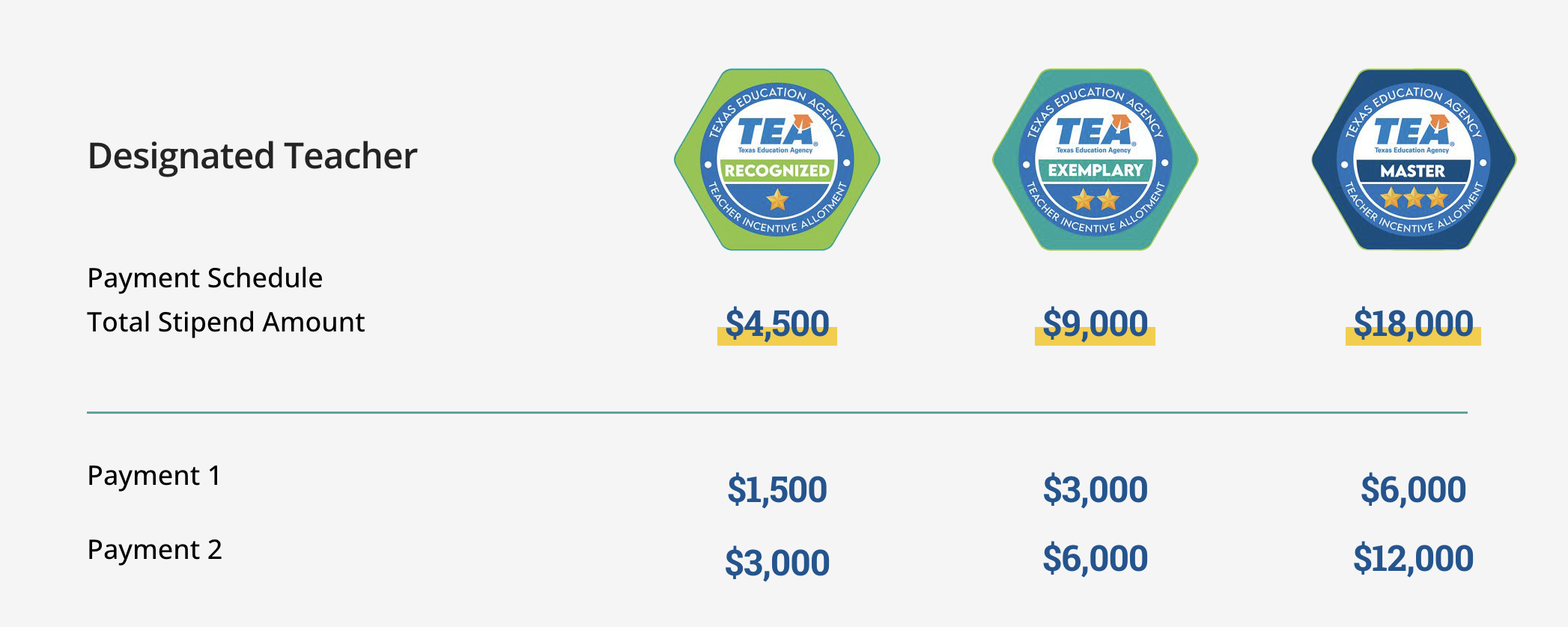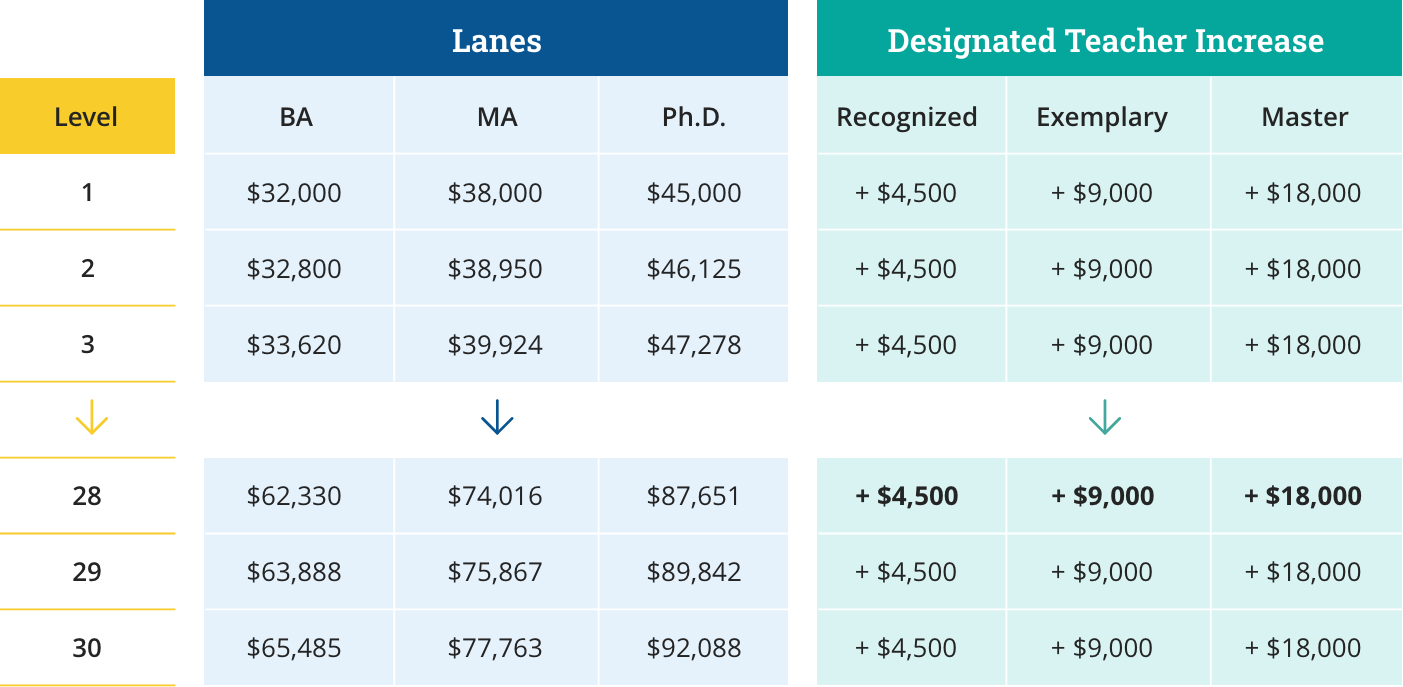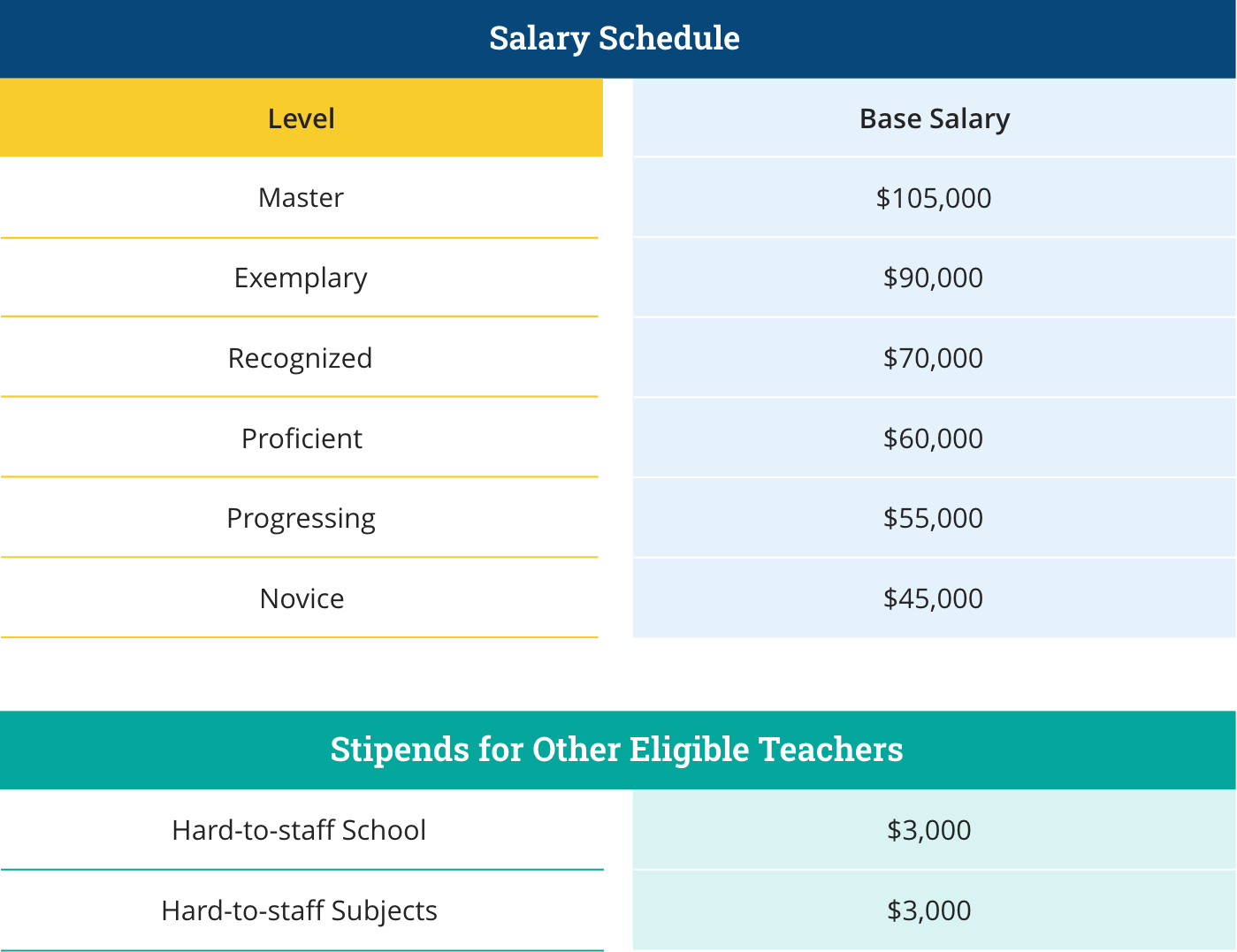General FAQ
What is TIA?
The Teacher Incentive Allotment (TIA) is a program that provides top-performing teachers an accessible pathway to a six-figure salary without having to leave the classroom. When a teacher earns a designation through their district’s local designation system, or holds a National Board Certification, the designated teacher generates extra funding for their district.
How do I contact a TIA team member?
The TIA Team provides training, ensures districts are well-supported throughout the process of developing and implementing a local designation system, and are available to answer questions. For questions, contact the team at tia@tea.texas.gov.
Where does TIA funding come from?
TIA funding was built into Texas state law as part of House Bill 3 during the 86th Texas Legislature. It is a Tier 1 allotment through the Foundation School Program (FSP), the system through which the state provides funding to districts. This system, grounded in the Texas Education Code, creates a sustainable funding source for districts implementing TIA.
Why should a district consider developing a local designation system?
By implementing a local designation system, districts are able to better support their teachers and their students. These systems will prioritize teacher learning and student outcomes; connect to campus and district best practices; incentivize teachers to stay; support more robust recruitment; and make the educator profession more desirable.
Developing and Applying for a Local Designation System
How should the TIA lead be determined?
The TIA lead must have the expertise, capacity, and high-level support to lead the work. While some districts may create a position specific to leading their TIA local designation system development, most designate existing personnel to lead TIA while performing other essential functions. The TIA lead should have regular access to district leadership when key decisions are made.
District TIA leads often work in human resources, teacher appraisal, or curriculum and instruction. A best practice for larger districts is to select two or more TIA leads working in different departments.
What happens if a TIA lead leaves the district?
If the TIA lead retires, resigns, or moves into a new role, districts may update their contact information by emailing TIA@tea.texas.gov. TEA encourages districts to have at least one back-up point of contact who is aware of the district’s TIA plans and can access documentation.
Learn more about the role of a TIA Lead.
How can districts include Special Education teachers in the local designation system?
Some districts choose to begin with a subset of teaching assignments or campuses and then create plans to expand their system after initial approval. As district teams build their local designation system, they can include support teachers such as interventionists, SPED inclusion, and dyslexia teachers if they are employed as a teacher (087 Role ID in PEIMS) and have a valid and reliable student growth measure.
Review this resource to learn more about integrating Special Education teachers in the TIA local designation system: TIA Special Education
Can a district phase in groups of teachers over time?
Yes. Districts have local flexibility to develop their local designation systems. For example, a district may choose to include only math and reading teachers in year one, and then expand to include science and social studies teachers in year two, etc. Districts must submit an expansions/modifications application by April for changes to begin capturing data for new teacher groups the following school year.
Can a district apply for TIA only at specific campuses in its district and not others?
Yes. Districts must specify which campuses are eligible under their local designation system and are not required to include all campuses. However, the district may still receive funds for designated teachers employed at campuses that are not included in their local designation system.
Can 1882 partners apply for a local designation system?
Yes, 1882 partners may apply for their own local designation system with sign off from the parent district superintendent. All funds are awarded to the district. 1882 partners and their districts must work together to ensure that funding for teachers employed by the partner is transferred and spent in compliance with statutory requirements. 1882 partners should apply and develop unique systems for each of their district partnerships.
In some cases, the district includes 1882 partner-operated campuses in their local designation system and collaborates with the partner to ensure the system is implemented with fidelity.
Can interventionalists or inclusion teachers be included in the local designation system?
It is a district decision whether or not to include support teachers in the local designation system. TEA does not limit eligibility to teachers of record. Teachers must be coded with a 087 teacher role ID in PEIMS to be eligible.
What is the time frame to apply, and what happens after a district’s local designation system is submitted for review?
Districts must submit a completed application by April to begin implementing their accepted system and gathering teacher performance data the following school year. TEA reviews system applications and notifies districts by late July whether the application was accepted.
When should districts begin communicating with teachers about their local designation systems?
Districts are encouraged to communicate with teachers early in the process and throughout the development and implementation of their local designation systems. The TIA Readiness Checklist includes a section on community and teacher communication.
What student growth measures can be used for teachers in non-tested subjects?
Districts can use locally developed or third-party student growth measures, as long as they are valid and reliable. Examples include SLOs, pre- and post-tests, industry certification exams, and student portfolios. Districts may find the T-TESS Guidance on Student Growth Measures (PDF) helpful as they consider different student growth measures. For more information, visit texasslo.org.
Can the district utilize existing student growth measures for the local designation system?
Districts may begin by looking at the student growth measures already in place for each assignment and exploring which assignments may require a new or modified option.
The timeline for implementing new student growth measures is often a top consideration when determining eligible teaching assignments and readiness to apply for a local designation system. Districts can opt to start with teaching assignments which already have valid and reliable growth measures while exploring student growth measures for additional teaching assignments in subsequent years.
Is TIA limited to Teachers of Record?
TEA does not limit designations to teachers of record. Districts may also include support teachers such as interventionists, SPED inclusion, and dyslexia teachers if they are employed as a teacher (087 Role ID in PEIMS), are appraised using an approved rubric, and have a valid and reliable student growth measure.
Funding & Spending Plans
What deductions can be taken from teacher payouts?
Like other income, TIA teacher payouts may be subject to taxes and retirement contributions. All compensation from TIA is TRS eligible. Districts may pay employee and employer contributions from the 90% portion of the allotment or from the 10%, as those benefit payments are considered to be included in overall compensation. See our TIA Guidance for District Business Offices for more details around how districts can issue payouts.
Will the agency monitor district compliance?
The agency utilizes authority found in TEC §48.004, §48.270, and §48.272 to audit districts in their compliance with Texas Education Code and Texas Administrative Code.
How can districts use the allotted funds?
Districts must spend at least 90% of the allotment on teacher compensation on the campus of the designated teacher, while up to 10% can be used to support the local designation system.
Within these parameters, districts may choose to split the allotment funding in several ways. Some districts choose to give the full 100% of funding to their designated teachers. Other districts choose to split the funding to reward other eligible educators who contribute to student success, such as instructional paraprofessionals.
Districts may use funds from the 10% to provide additional professional development opportunities to designated teachers and teachers who may be eligible for designation in the future.
Learn more about how districts are allowed to use the allotted funds.
What is an example of a TIA stipend plan?

In this example, the stipends are paid out in two payments, with a larger final stipend paid in August as a retention bonus for those educators returning to the school.
What is an example of a TIA salary raise plan?

In this example the TIA performance raise for designated teachers is created by adding lanes to the district’s standard teacher salary schedule. The amounts in the Recognized, Exemplary, and Master lanes are added to the designated teacher’s salary based on where they fall within the standard steps and lanes.
What is an example of a TIA combination plan?

This example uses a salary schedule ranging from Novice for new teachers to Master for the highest performing teachers. It includes stipends of $3,000 as an incentive for teachers to work in hard-to-staff schools and hard-to-staff subject areas.
How do districts manage allotments if designated teachers leave?
Districts need a plan for teachers who resign prior to the scheduled payout date. Some districts may choose to forward the full or remaining payment to the designated teacher. Other districts may choose to use the funds to compensate teachers who remain on the campus. All funds must be spent by August 31.
Is the allotment for the teacher or the campus?
Funding for teachers designated as Recognized, Exemplary, and Master under TIA are awarded to districts, which in turn must spend at least 90% of the funds on teacher compensation on the campuses where the designated teachers work.
TEC Section 48.112 (i)(1)(A): A district shall annually certify that funds received under this section were used as follows: At least 90% of each allotment received was used for the compensation of teachers employed at the campus at which the teacher for whom the district received the allotment is employed.
What is the timeline for receiving TIA funds?
For the first year of a teacher’s designation, districts are notified of funding amounts by designation level and campus in the spring, and funds arrive the following September in settle-up. Following the initial payment, districts receive regular funds based on projections according to their regular FSP payment schedule, with settle-up each September.
Will there be spending codes for TIA funds?
There are no PIC codes for TIA funds. Funding and reimbursement of fees are a separate line item in FSP payments.
Will the campus socioeconomic tier data be recalculated every year?
Yes. Given that a school’s student enrollment changes yearly, the campus’ socioeconomic tier is recalculated annually. As a reminder, this calculation uses the home addresses of students who attend a particular campus. Allotment funds for each designated teacher are based on the campus, and not the individual students assigned to the designated teacher.
If a designated teacher moves campuses from one school year to the next, will the allotment that teacher generates be recalculated? What if a teacher leaves in the middle of the year?
While designations are tied to the teacher and not their employing district or campus, allotment funds are awarded to the district where the teacher was employed as of the last Friday in February. For teachers who meet eligibility criteria, the district employing the teacher as of the last Friday in February will receive funds for that school year and must spend the allotment funds by August 31. The percentage of allotment awarded to the designated teacher varies by district. Districts are not required to forward funds if the teacher resigns or retires before August 31. If a designated teacher moves to a new district or campus between school years, the allotment for the next school year will be recalculated in April based on the new campus’ rural status and level of socioeconomic need.
If a district does not have a local designation system as part of the Teacher Incentive Allotment, but employs designated teachers, will the district receive allotment funds for those teachers?
Yes. Districts that employ teachers who have earned designations will receive funding for those teachers based on the TIA formula, even if the district does not have an approved designation system in place.
For example, a district that does not have a designation system in place could employ a teacher that earned a designation in another district or a teacher who automatically earned a Recognized designation for having achieved National Board Certification. Districts need to develop a plan for how to spend allotment dollars that they receive, in accordance with the statutory requirements.
System Implementation
What if a teacher works in more than one eligible teaching assignment
Districts may use data from one or multiple eligible teaching assignments in the same eligible teacher category. This is a local decision.
How will TEA know if Student Learning Objectives (SLOs) are measuring growth effectively?
The application for a local designation system requires districts to explain in detail their procedures and protocols for SLO implementation, including procedures for setting student preparedness levels at the beginning of the year, protocols for collecting the body of evidence of student work, and rubrics/protocols used to approve SLOs at the end of the year. All districts must go through the data validation process before TEA determines full system approval.
Many districts allow eligible teachers to waive an annual appraisal. Will an annual appraisal be required for teachers to earn a designation?
Districts must have observation and student data from the data capture year for all teachers in the district’s system. After receiving full system approval, districts may have teachers on appraisal waivers, but those teachers may not be submitted for proposed designations. An annual appraisal is required for teachers to earn a designation. TEA cautions districts to use waivers sparingly following system approval, as this may impact future data validation and future proposed designations. Appraisals must comply with §21.351 and §21.352.
Once approved districts submit their data in the fall following their data capture year, will they be required to continue submitting data for the next four years?
After the data capture year, districts continue to submit data for validation each year they wish to put forth teachers for new or higher designations.
What data will schools be required to submit for the data validation process?
Districts are required to submit dimension-level observation scores and a student growth rating for all teachers in eligible assignments. Read more about data submission and validation.
Will districts have to submit data every year?
Districts submit data for all teachers in eligible teaching assignments each year that they put forth new teachers for designation.
If a system is not approved, can the district resubmit data the following year?
Systems that fail to pass data validation may resubmit the following year.
Designation Policies
Who is eligible to earn a designation through a local designation system?
Teachers employed in eligible teaching assignments may be submitted for designation based on the prior school year’s performance data. Districts may submit teachers for designation if they meet the following criteria:
- Still employed by the designating district in a teaching role
- Meets the district’s performance criteria for designation based on teacher observation and student growth data from the prior school year
- Minimum observation score of Proficient in each observable dimension in the prior school year
TEA will conduct additional eligibility checks prior to awarding designations.
What if a designated teacher moves to a non-teaching role, such as instructional coach, counselor, or administrator?
Designated teachers who move to a Role ID other than 087 will maintain their designation. However they will not generate annual allotment funding if they are not in a 087 teaching role. Teachers who move to a non-teaching position prior to formally earning a designation relinquish eligibility.
Are designations attached to a particular grade level or subject area?
Unlike certificates, designations are general. The designation is placed on the teacher’s SBEC certificate and does not specify a certification area, subject, or grade level. A teacher may change teaching assignments and will still generate allotment funding. The same applies to National Board Certified Teachers (NBCTs).
What if a designated teacher’s performance level changes within the five-year period? Can their designation level change?
Teacher designations are valid for five years. Within the five-year period, teachers may be put forth for a higher designation if their performance qualifies them, but they cannot be submitted for a lower designation. Some district spending plans may include variability based on continued performance levels.
What happens after the five-year designation expires?
Designated teachers who meet performance standards and district qualifications can be put forth for a new designation in the fall after the designation expires. The new designation will be retroactive to the beginning of the school year. Once the designation expires, it will be removed from the SBEC certificate (if applicable) and allotment funding will no longer be generated.
System Renewal
Does a district’s plan to expand or modify the local designation system at the time of renewal require a separate, additional Expansion and Modification Application?
No. The completion of the Renewal Application supplants the need for a separate Expansion and Modification Application in the same year.
If a district has submitted an Expansion and Modification Application since their initial System Application, do they still need to apply for renewal?
Yes. All districts that received initial system approval must submit a renewal application to continue to operate an approved TIA system. Districts are encouraged to access and complete the renewal application as early as possible in the required renewal year to ensure the application deadline can be met.
Can districts with an approved system submit an early Renewal Application?
No. Districts will be notified directly when renewal applications are required and should plan on renewing in the fourth year after the approved system application.
What happens if a district does not apply, or is not approved, for renewal?
Districts can designate teachers in the last school year of their five-year system approval period based on the previously approved system. However, the district’s prior approved system would expire and would not be eligible to designate teachers in the following school year.
National Board Certification
What is National Board Certification?
National Board Certification is a voluntary, advanced professional certification for PreK–12 educators that identifies teaching expertise through a performance-based, peer-reviewed assessment. More than 125,000 teachers across all 50 states have achieved Board Certification.
What is required to become a National Board Certified Teacher?
The certification process is designed to collect standards-based evidence of accomplished practice. To become a Board-certified teacher, eligible candidates must demonstrate advanced knowledge, skills and practice in their individual certificate areas by completing four components. The content knowledge component is a computer-based assessment taken at a testing center; the other three are portfolio-based and submitted through an electronic portfolio system.
Component 1: Content Knowledge
Component 2: Differentiation in Instruction
Component 3: Teaching Practice and Learning Environment
Component 4: Effective and Reflective Practitioner
What if a National Board Certified Teacher works in a district that is not participating in TIA?
Districts are not required to have a local designation plan to receive funding for Recognized NBCTs or seek reimbursement of eligible fees paid to the National Board. Eligible NBCTs earn a Recognized designation and generate annual allotment funding regardless of their district participation in TIA. Districts receiving TIA funds for NBCTs are required to abide by the spending requirements outlined in statute: 90% of allotment funds must be spent on teacher compensation on the campus where the designated teacher works.
NIET EE PASS FAQ
How can my district gain free access to the NIET EE PASS?
Districts must fill out the form above to access the resource library. Districts will be prompted to provide information for the individuals requesting access to ensure accounts are generated accurately.
Questions about registration access should email support@niet.org.
Once my district has a login, what will I find in the NIET EE PASS resource library?
The resource library contains four types of resources for districts to use: Video Library, Conference Archives, Training Modules, and Document Library. The video library contains split-screen videos of teachers & students and the scores, and evidence aligned to the Texas Teacher Evaluation & Support System (T-TESS) rubric indicators and/or the NIET TAP rubric, where applicable.
What if my district does not use the NIET TAP or T-TESS rubrics in our local appraisal system?
Districts for all approved appraisal systems can leverage the resources in the NIET EE PASS resource library. However, districts using locally developed, Marzano, or Danielson rubrics would need to align the video resources to rubrics and indicators, as these would not be provided for all videos.
Who do I contact if I have questions about the NIET EE PASS resource library?
Once logged into the portal, users should contact NIET directly using the “Contact Us” function.
Reports & Updates
Legislative Updates
Legislative Update: Teacher Incentive Allotment (TIA) Impacts
